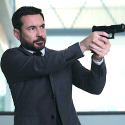With the 70th anniversary of D-Day following hard on the heels of the extensive World War One commemorations, battle fatigue is becoming a very real concern for TV-watchers. Breaking the mould of retrospective war documentaries becomes increasingly difficult, as Messrs Enfield and Whitehouse demonstrated with deadly satirical accuracy in Harry and Paul's Story of the 2s, so all kinds of credit are due to National Geographic's frequently devastating record of the D-Day landings and their immediate aftermath.
Although this was a multinational collaborative effort, the premise was straightforward. The two one-hour films told the invasion story via news footage shot before, during and after the landings, most of it of astoundingly high quality, and it had been digitally converted from the original black and white into colour. Even in the wake of a movie like Saving Private Ryan, which brought home the terror and chaos of the battlefield with hideous intensity, this real-life archive material delivered galvanising shocks of its own (below, German commander Erwin Rommel inspects the Normandy defences). Robert Capa's startling still photos from Omaha Beach lent an additional frisson of actualité.
 The tale of the elaborate planning for the Normandy invasion, with its massing of forces in southern England and cunning ruses to convince the Germans that the real target was the Pas-de-Calais, has been told often enough, but scenes of paratroopers blackening their faces with boot polish before roaring off to be dropped in darkness behind the German front lines before the invasion began made real the near-suicidal nature of the exercise. Over footage of American troops clambering into landing craft in unpleasantly choppy seas off the Normandy coast, we heard the words of GI Samuel Fuller (the future movie director), wondering if posterity would record the way the decks of the boats were covered in so much vomit it was like walking on an ice-rink. We heard Fuller's words again as the troops struggled off their boats towards the beach - "I swallow a ton of water, mixed with American blood."
The tale of the elaborate planning for the Normandy invasion, with its massing of forces in southern England and cunning ruses to convince the Germans that the real target was the Pas-de-Calais, has been told often enough, but scenes of paratroopers blackening their faces with boot polish before roaring off to be dropped in darkness behind the German front lines before the invasion began made real the near-suicidal nature of the exercise. Over footage of American troops clambering into landing craft in unpleasantly choppy seas off the Normandy coast, we heard the words of GI Samuel Fuller (the future movie director), wondering if posterity would record the way the decks of the boats were covered in so much vomit it was like walking on an ice-rink. We heard Fuller's words again as the troops struggled off their boats towards the beach - "I swallow a ton of water, mixed with American blood."
If some scenes looked superficially familiar from previous WW2 documentaries, it was if they'd just been black and white trailers for the real thing assembled here. There was a lengthy scene of Canadians landing at Bernières-sur-Mer, and you felt like you were jostling elbow to elbow with them and sharing their ghastly sensation of helplessness as the German gunners opened fire. In footage of Americans trapped at the base of the cliffs on Omaha Beach, the shock and exhaustion on their faces made words unnecessary. A glimpse of human entrails slopping around inside a landing craft was merely unspeakable.
 There was some remarkable material from the German side too. We saw SS tank regiments carrying grinning teenagers from the Hitler Youth towards the beaches to try to fight off the invaders, and the camera looked straight down the barrel of German guns firing at Allied fighter-bombers as they thundered low overhead (wrecked German tank, above).
There was some remarkable material from the German side too. We saw SS tank regiments carrying grinning teenagers from the Hitler Youth towards the beaches to try to fight off the invaders, and the camera looked straight down the barrel of German guns firing at Allied fighter-bombers as they thundered low overhead (wrecked German tank, above).
But it wasn't all shooting and explosions. There were voice-over accounts from French civilians who watched it all happen with a mixture of terror and euphoria, while the diaries of Kay Summersby, General Eisenhower's chauffeur, gave a cool and analytical insider's perspective (although the bit where she described an intimate encounter with the Supreme Commander raised the temperature somewhat). There was a glimpse into the future shape of post-war Europe too, as the climactic account of the liberation of Paris ended with General de Gaulle marching towards Notre Dame cathedral, rubber-stamping himself as the triumphant embodiment of liberated France. D-Day Sacrifice trenchantly evoked just what momentous days these were.















Add comment